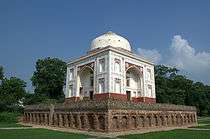Sunder Nursery
Sunder Nursery is a 16th-century heritage garden complex adjacent to the Humayun's Tomb, a UNESCO World Heritage site in Delhi. Originally known as Azim Bagh, it lies on the Mughal-era Grand Trunk Road, and is currently spread over 100 acres. The garden was originally built by the Mughals in the 16th century. Today it contains nine heritage monuments, including ASI-protected Sundarwala Burj, Sundarwala Mahal and Lakkarwala Burj. During the British rule, nursery was established to grow experimental plants, which gave it its current name, though much of the original garden was thus lost.[1][2]
Restoration

The garden complex is undergoing an extensive restoration project, undertaken by Aga Khan Trust for Culture India, jointly with Archaeological Survey of India (ASI) and Central Public Works Department (CPWD) which currently runs the garden. The project also involves restoration work 30 near by heritage structures.[3]
Plans for the project were drawn in 2007, and work on the third phase was initiated in 2010, and is part of the larger Nizamuddin Urban Renewal Project of the Aga Khan Trust.[4] Due lying abandoned for decades, much of the area has since overgrown, and during the initial work some 1,000 trucks of rubble was removed, before the ground was leveled and subsequently classical Persian gardens were recreated, with fountains and water channels. Two main architectural features were restored. The Lakkarwala Burj tomb is now set in a new rose garden, while the 16th-century Sunderwala Burj tomb was restored as per the orange sandstone and white lime mortar used in its original design. Its red sandstone interior walls saw entire sections of white Quranic verses being recreated.[5]
The garden is set to replicate the four micro-habitat zones which were part of Delhi’s original landscape namely Kohi (ridge), Bangar (alluvial), Khadar (riverine) and Dabar (marsh).
In 2013, a Mughal-era lotus pond was excavated, which is being restored. After restoration, the first phase of the project is set open to public in 2015.[3]
Important features
- Sunderwala Burj in the Sunder Nursery gardens
- Sunderwalla Mahal under restoration, 2012
- Water channel with fountains, near Sunder Burj Tomb
References
- ↑ "Aga Khan revives lost 16th century Mughal garden in heart of Delhi". The Daily Telegraph. 1 Sep 2013. Retrieved 2014-01-16.
- ↑ "Sunder Nursery blooms into a park". Deccan Herald. Jan 2, 2013. Retrieved 2014-01-16.
- 1 2 "16th-century lotus pond found in Sunder Nursery". The Times of India. Retrieved 2014-01-16.
- ↑ "Sunder Nursery, city's new oasis". Indian Express. Jun 11, 2010. Retrieved 2014-01-16.
- ↑ "Ratish Nanda plans on creating huge new park in Delhi". CNN-IBN. August 26, 2013. Retrieved 2014-01-16.
External links
| Wikimedia Commons has media related to Sunder Nursery. |